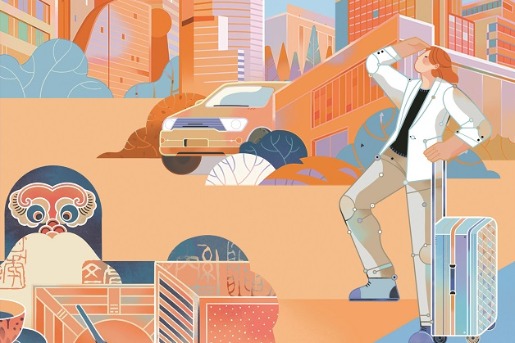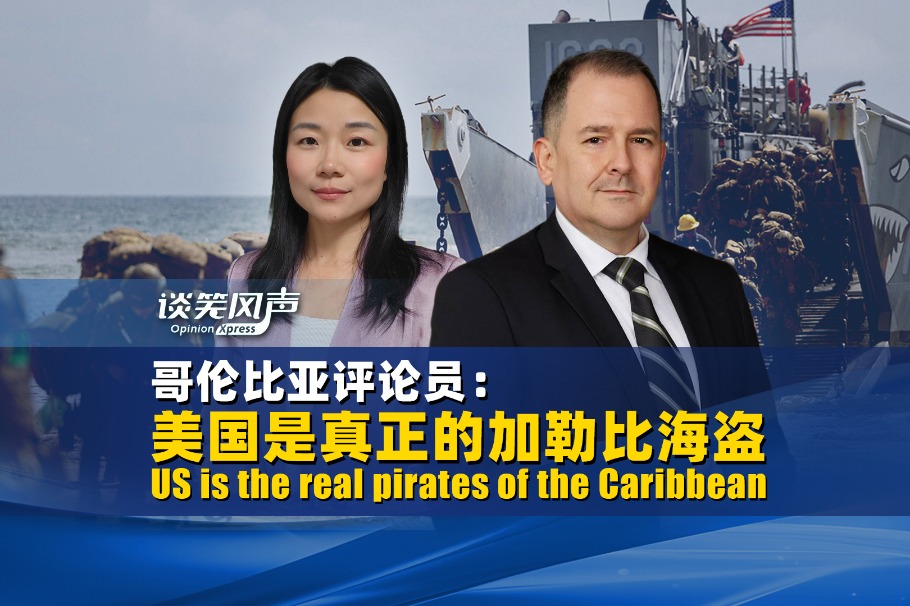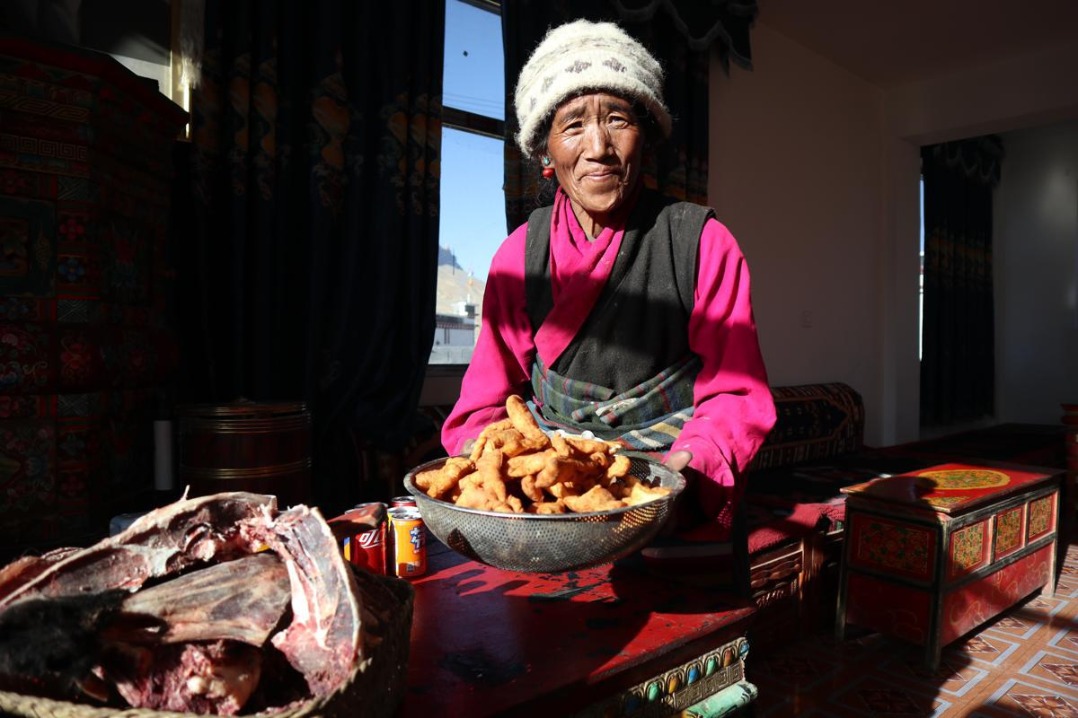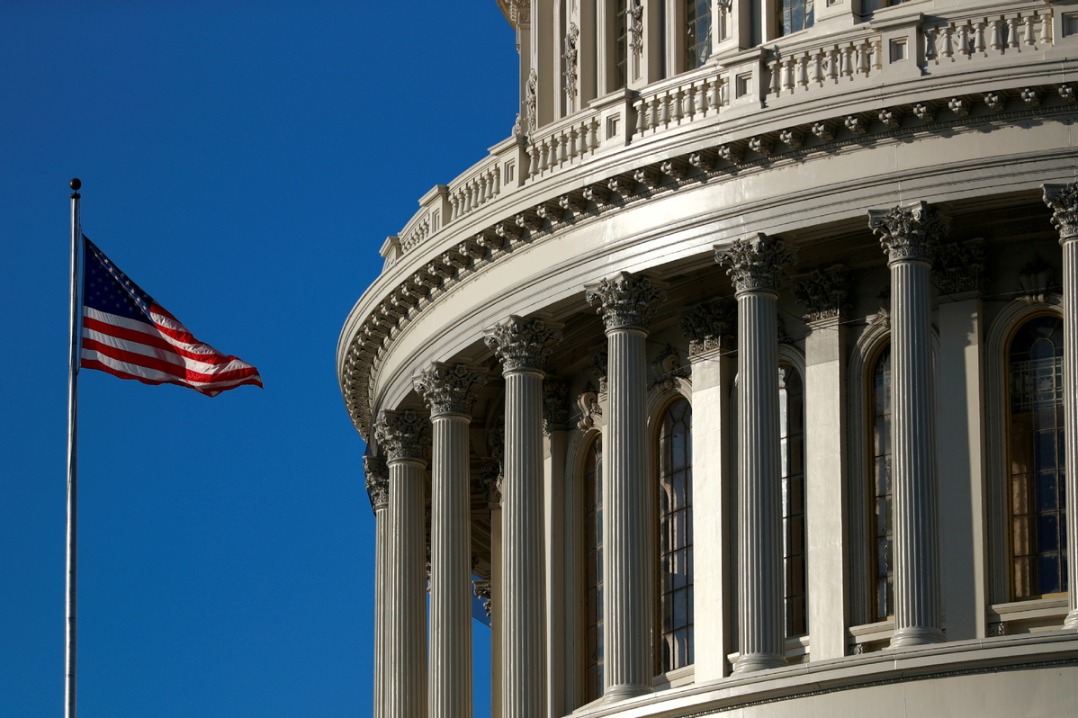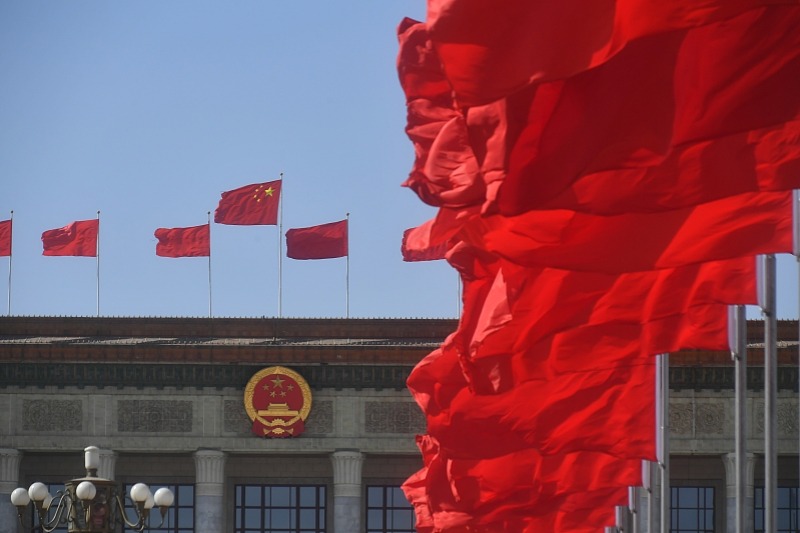The bubble of prejudice versus the light of hope in China's COVID fight

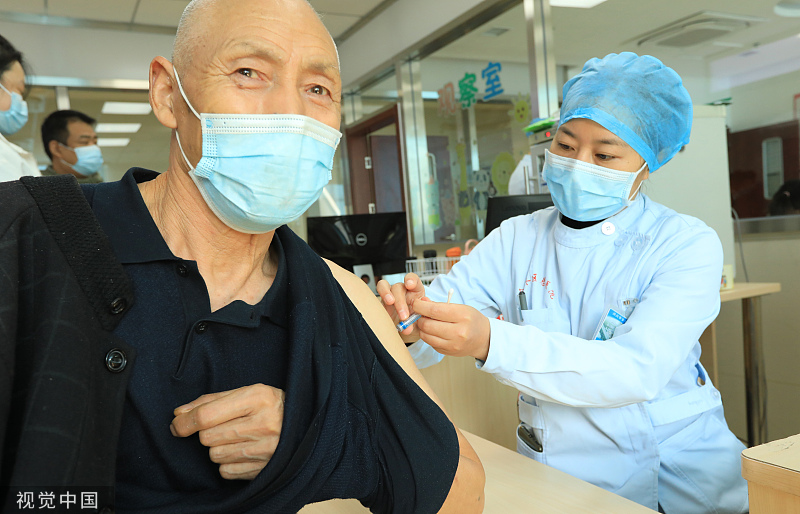
In the eyes of some Westerners, the word "delicacy" represents numerous possibilities and considerable diversity: spaghetti, Kung Pao Chicken, tacos, and French fries, among others.
Yet they refuse to accept the similar possibilities and potential for diversity embedded in the word "anti-pandemic."
Chances are, these people are the same ones who reject the fact that concepts such as "development models," "governance modes," "democratic paths," and "standards of human rights protection" are also de facto "plural."
They turn their ears away from hard truth and hide in flimsy bubbles constructed by their groundless prejudices, surmises, and self-invented myths.
Outside that blinding and deafening bubble, facts and statistics have demonstrated that China, a country with a population of 1.4 billion, has risen above waves of COVID-19 outbreaks with minimized impacts in all respects, in a targeted and science-based manner that best suits its own unique circumstances.
If only these Westerners could abandon their fault-finding mentality and take a closer look at China's COVID fight with what the Chinese would call a "seek-truth-from-facts" attitude, they would certainly arrive at a fairer conclusion.
LIGHT OF HOPE
If winter comes, can spring be far behind?
After three years of an assiduous and efficacious fight against the pandemic, China has recently announced that the priority of its COVID response is shifting from preventing infections to medical treatment. A series of optimization and adjustment measures were rolled out, with the objectives of protecting people's health and preventing severe cases.
The majority of Chinese have never had to face the pandemic head-on before, and after a few weeks of staying at home and convalescing indoors, they have managed to restore normalcy and return to the hustle and bustle of their daily lives.
Cities such as Beijing are regaining their pulse of vitality. In the metropolises, the once-empty subway trains are again crowded with mask-wearing commuters. Travel plans that had been shelved are now back on people's agendas, and a range of business opportunities and activities are gaining momentum.
More than 80 percent of movie theaters in China have reopened. Hollywood blockbuster "Avatar: The Way of Water," released in mid-December 2022, had garnered cumulative earnings of over 1 billion yuan (about 144.65 million U.S. dollars) by the first day of 2023.
But people don't get to read about the promising side of China in some of the Western media, which are now drawing a sketch of devastation in the world's second-largest economy, and hyping their "concerns" for "a dark COVID winter."
If their reporters had paid any real attention to China and were truly concerned about its people, they would have noticed that the Chinese are getting help and warmth from all sides.
China does not shy away from acknowledging the challenges it faces, and is ramping up vaccination efforts among the elderly and increasing the capacity of intensive care units (ICU).
The Chinese government and the people are striving together to flatten the curve of COVID-19 infections, shorten the queues outside hospital emergency rooms, and reduce heart-wrenching toll inflicted by the virus.
It is in no way an easy job. Fortunately, the people's courage and sense of responsibility have given them the faith and determination to carry on, despite fears and obstacles - and such sentiments abound in China.
Authorities have been continually fine-tuning the allocation of medical resources and ensuring sufficient supplies of medicines to the public. Machines are humming around the clock in the workshops of Chinese pharmaceutical companies.
In less than a month, the daily output of ibuprofen and paracetamol, key drugs for fighting pain and fevers, has expanded more than four times, while the daily production capacity of COVID-19 antigen test kits has grown from about 60 million to some 110 million during this period.
China, a country that upholds the tradition of prioritizing and respecting the elderly, has demonstrated its attentive consideration and care for the gray-haired. Healthcare workers go door-to-door to help vaccinate the elderly. The average occupancy rate of hospital beds for severe cases across the country has not yet reached the 80 percent mark.
Chinese people share advice from prestigious epidemiologists via their social media accounts, while communities hand out care kits, packed with medicines and other pandemic prevention materials, distributed by local governments.
In a number of cities, nucleic acid testing booths were transformed into one-stop fever clinics, with the whole process from diagnosis to the dispensing of medications taking just 10 minutes.
Special attention is being directed to the medical situation in rural areas, where clinicians and drugs are relatively inadequate. Inequalities based on ethnic groups, family backgrounds, or economic status, which generated negative multiplier effects on the transmissibility and lethality of the virus in some other countries, have no room in China.
The "tide of COVID deaths" has not appeared in the world's most populous country. Thanks to its arduous efforts over the past three years since the COVID-19 outbreak, China has managed to keep its severe cases and death rates among the lowest in the world.
A government that has saved millions of lives and safeguarded people's health should not be misunderstood and discredited in the way that has been seen in some Western media reporting on this topic.
People always make an analogy between the pandemic and a mirror, as the strengths and capacities of governments in various countries are reflected and exposed thoroughly.
At present, China is still fighting an uphill COVID battle. But as it was pointed out by the Chinese leader in the 2023 New Year address, "The light of hope is right in front of us."
THE 7TH SLICE OF CAKE
When China late last month announced the downgrading of the management of COVID-19 starting from Jan. 8, 2023, putting it on a par with HIV and viral hepatitis rather than the more serious infections such as bubonic plague and cholera, some did wonder about the timing of the policy shift. "Why now?"
Such speculation, together with the rise in the number of infections in some Chinese cities following the policy shift, seemed to have given some Western media and politicians more ammunition to continue their attack on China's COVID response.
Just as they had been doing over the past three years, they tried to paint China's latest policy optimization and adjustment - in their words, "a U-turn" - as yet another mistake.
They claimed China's decision was based "on impulse" and made "with no preparation." They argued that it would "cause economic disruption" and "push up global inflation," posing risks to the whole world.
Oddly enough, however, when other countries eased their COVID restrictions back in 2021, at a time when the pathogenicity of the virus posed a much greater danger and uncertainty to the world than it does now, those who are now crying crocodile tears for the Chinese people were far less nit-picking.
You can't wake a person who is pretending to be asleep, can you? The monotonous negative depiction of China's COVID responses by those biased minds can be precisely summarized as "Wrong! Wrong! Still wrong!" The "only constant" is their blind criticism of China's COVID policies. Maybe it is not about COVID policies after all. Maybe it is just about having a go at China.
In May last year, an article published by Fortune quoted an expert as saying that China's strict COVID policy would result in "disruption to economic activity." Last month, however, it was the same author who questioned China's adjustment of its COVID response, claiming the "inevitable COVID outbreak" to follow would likely "cause further economic disruption."
To the naysayers, strict prevention and control measures are wrong. Adjustments and optimizations are wrong. To them, no matter when or how China optimizes or adjusts its COVID policy, China is still doing it wrong.
Contrary to their self-invented surmises, China's latest COVID policy shift was a result of the country's scientific assessment of the pandemic and based on prudent planning, as well as a timely response to the yearnings of the people. It's all about the right time, the right place, and with the right people, as the Chinese would put it.
It is based on the plain facts of the weakening pathogenicity of the virus, a rather solid immunity barrier, and the increasing accumulative experience in the pandemic response.
Over the past three years, China has equipped itself with technologies and drugs that are proven to be effective in COVID-19 diagnosis and treatment, and has also made continuous progress in terms of pathogen detection and epidemiological investigation.
Over 90 percent of the population has been fully vaccinated thanks to China's unceasing efforts in vaccine research and development, while people's health awareness has also been greatly enhanced.
In other words, while the virus is becoming weaker, the Chinese people are becoming better equipped to fight it. You do not need to be an epidemiologist to come to the obvious conclusion.
So, when China was presented with a critical "window of opportunity," it took the initiative to refine its COVID response measures.
Despite a short period of quickly rising infection levels, the impact of the pandemic on China's economy and society has remained within an expected, manageable range. In that sense, the latest COVID policy shift is without doubt science-based, proactive, and in line with China's own realities.
One key hallmark of China's fight against the pandemic, aside from being pragmatic all along, is the delicate balance it has struck between protection and the prevention of over-protection. Achieving such a balance is almost natural and instinctive for a country that has long believed in the golden mean - or not going to the extreme of one or the other.
Following a science-based and targeted approach, China has adapted its COVID response in light of the evolving situation to meet the most pressing needs of the people.
Since 2020, Chinese health authorities have issued nine editions of prevention and control plans, and diagnosis and treatment plans, to guide the fight against COVID-19.
It issued 20 measures in November 2022 and 10 more in early December to further optimize its response, before the latest downgrade of COVID management, opposing both "lying flat" and "one-size-fits-all" philosophies.
Now, some in the West are questioning why China is choosing to open its borders at this point in time, and why the country refrained from asking people to be the "first person responsible" for their own health at an earlier stage.
The truth is, in the earlier stage of the pandemic, as COVID and its Delta variant wreaked havoc all over the world, the majority of people worldwide, particularly the elderly and other marginalized and vulnerable population groups, were ill-equipped to be the "first person responsible" for his or her own health.
The Communist Party of China and the Chinese government played a key "empowering" role during that stage, by leveraging its strong leadership and strength in grassroots mobilization, organization, and governance - part of the competitive edge of its system which can "concentrate power to accomplish big things" - to help people arm themselves against deadly viruses as quickly as possible.
Those three years of daunting combat with various virus strains from Delta to Omicron have laid the foundation for China's adjusting and optimizing of its COVID policies. The country would not have been able to enter a new phase of COVID response had it not been for the hard work of the past three years.
There is a joke that you might have heard. A hungry fool ate seven slices of cake and was finally full. He said to himself, "Why didn't I eat the seventh slice sooner and be full already? The first six were such a waste."
Anyone who thinks of China's latest COVID policy shift as a complete negation of the country's daunting fight against the pandemic over the past three years is that fool.
PEOPLE FIRST PHILOSOPHY
The COVID-19 pandemic has posed a series of tests for the world, and different countries have delivered different answers based on their own philosophies. Some prioritize individual freedom over life, while some others place economic considerations above human casualties.
In a sense - there is no simple way to identify the best option - but the multiple options can be analyzed from the perspective of whether they have been suitable for a country's own national conditions and have had the optimal impact.
Judging other countries' COVID responses using one's own standards will only lead to misunderstanding, estrangement, and even hostility.
Three years on, China's COVID battle has been deliberately portrayed by certain Western media outlets as a tale of flux and self-contradiction.
-- When the unprecedented pandemic initially broke out, China was framed as a fictitious "virus maker."
-- When certain Western countries hoarded vaccines, and Chinese vaccines became the only ones that some developing countries could count on, China was falsely accused of engaging in "vaccine diplomacy."
-- When China curbed dozens of sporadic outbreaks, the accomplishments were jealously described as "too good to be true."
Recently, when China took stock of the pandemic situation and rolled out its optimized and adjusted measures, those supporters of "lying flat" who proposed herd immunity when little was known about COVID-19's pathogenicity during the initial stage of the outbreak, seemed to have forgotten their own rashness at that time and started to find and harp on faults in the "disorder" of others.
This was a brazen smear that defied facts, science, and morality. Such a narrative misrepresented China, with some Western media outlets turning a selective blind eye to China's consistent philosophy and strategy in fighting COVID-19.
To cope with the pandemic, China applied a down-to-earth approach. It put the people and their lives above all else during its pandemic battle. This is the true meaning behind the government's solemn commitment to ensure people's right to life and right to health.
Life is the most valuable. Without life, no other values can be meaningfully discussed. As a Chinese saying goes - "With the skin gone, to what can the hair attach itself?"
China, the world's largest developing country, prioritizes the right to life as a fundamental human right. In the past three years, it has never given up on protecting its people from the threats posed by the virus, regardless of whether these people are newborns or centenarians.
The country has always "put the people first" instead of "put pandemic prevention and control first." Some measures do bring inconvenience to daily life, but their purpose is to bring social life back to normal as soon as possible and in a step-by-step way.
China's COVID policy is a science-based one. In China, there is no room for being derailed from the scientific track due to partisan strife, resulting in an upside-down anti-pandemic policy, or anti-intellectualist nonsense such as injecting disinfectant into a man to kill a virus.
By contrast, in some Western countries where individual freedom is overemphasized, vulnerable groups have become more vulnerable during COVID-19 outbreaks. The inflation and unemployment seen during the pandemic have crippled their governments' agenda of trading economic opportunities with people's health.
Such anti-pandemic approaches have nothing to do with freedom, equality, or fraternity, but result only in a severe deviation from such values which Western countries have taken pride in.
Behind the West's apparent state of "normality" is a real "abnormality," the loss of lives and the breaking of hearts within families. Beyond the so-called freedom and the carnival atmosphere, a painful price is being paid.
The latest COVID-19 data from Johns Hopkins reveals that the United States, boasting the most cutting-edge medical techniques, is among those countries that have suffered the worst outbreaks, with over one million deaths.
Such data makes some Western media's remarks, such as "China's COVID Success Story is Also a Human Rights Tragedy," look ridiculous.
China succeeded in saving people's lives but this led to a human rights tragedy? What is this? Oxymorons in Shakespeare's plays?
SHARED DESTINY
One can easily imagine that, in the foreseeable future, Chinese tourists will be seen once more posing for selfies in front of the pyramids of Egypt, at the Acropolis Museum in Greece, and on the beaches of Thailand's Phuket island.
At the same time, more foreigners will arrive in China, hiking the Great Wall and marveling at ancient artworks such as the cave frescoes on the northwestern edge of China's Gobi Desert.
As the world's largest outbound tourism market before the pandemic, China's recent policy shift to facilitate safe and orderly cross-border travel has been heartening news for the world - embassies and tourism authorities of various countries posting messages on social media platforms to welcome Chinese tourists.
Certain countries' newly imposed restrictions on travelers from China were widely criticized.
As the world's second-largest economy, a global manufacturing powerhouse, and the largest trader of goods, China's response to COVID-19 has far-reaching implications for the whole world.
What would life be like if the world was without the products of Apple, Tesla, Huawei, OPPO, and DJI, or the toys, shoes and socks, jerseys, batteries, luggage and bags, and fertilizers from China?
Had it not been for China's proactive COVID containment strategy and the quick resumption of production in Chinese factories, shortages of goods would probably have nudged up retail prices in Walmart and Tesco stores across the world, and those suffering from global inflation would have been in a worse situation.
China's steady development, in and of itself, has been a major contributor to the world in the shadow of COVID-19.
Those who accuse China of "disrupting" the global supply chains with its pandemic prevention and control policies are clearly confusing right and wrong. Had it not been for China playing a stabilizing role, the global industrial and supply chains would have been under greater pressure.
Avoiding the Chinese market is an unrealistic idea. China registered an average annual economic growth of around 4.5 percent over the past three years - significantly higher than the global average.
During the first three quarters of 2022, foreign direct investment (FDI) in the Chinese mainland, in actual use, exceeded 1 trillion yuan, equaling that of the entire 2020.
These eye-catching figures reflect the close connection between the Chinese economy and the global economy during the pandemic, as well as the confidence of profit-driven international capital in China's economic resilience and market potential.
What has also been closely binding China to the rest of the world are life-saving COVID-19 vaccines.
Calling its home-grown vaccines "people's vaccines," China is the first country to propose COVID-19 vaccines as a global public good, the first to support vaccine intellectual property rights exemption, and the first to carry out cooperation on vaccine production with developing countries.
So far, China has sent teams of medical experts to 34 countries to fight the pandemic, and offered over 120 nations and international organizations 2.2 billion doses of COVID-19 vaccines, in pursuit of closing the fatal vaccination gap.
In his new book about China, a Spanish reporter wrote that one out of every two doses of vaccines that Latin America received was made in China. While the United States and Europe supplied 45 million doses of vaccines, China sent 245 million doses to Latin America, according to this book.
China has never created any kind of "information black hole" in decoding COVID-19. Ever since the pandemic broke out in Wuhan three years ago, the country has been sharing the virus gene sequence with other countries, in order to achieve a better understanding of this cunning and elusive virus.
Today, as China shows strong signs of recovery, the world is excited. China's economic rebound, as widely predicted by investment institutions, will act as a "counterweight" to a potential global recession.
A report by German media outlet FOCUS Online said Germany will benefit from China's recent adjustments of anti-virus measures in three respects: products like cars are likely to become cheaper in Germany; German companies and investors will earn more profits as more customers flock to their stores in China; and jobs in German companies will become more stable.
Ever since ancient times, Chinese people have pursued the ideal of "great harmony in the world."
Today, China is promoting the building of a community with a shared future for humanity. As we face a common enemy in the form of the pandemic, perhaps more people can really gain an understanding of the meaning of this proposal.
YARDSTICK AND CONSENSUS
When future historians retell the story of this unprecedented pandemic, it will not merely be a story of havoc, death, and despair for sure.
It will be a story concerned with science and exploration, a story about how societies struggled with the havoc caused by the infectious virus, a story balancing personal freedom with respect for the views of others, a story that guides us in how to think calmly, make bold choices, and put them into action decisively, despite chaotic circumstances.
Joseph Stiglitz, Nobel Prize-winning economist, said countries have manifested "marked differences" in managing the pandemic, in terms of safeguarding the health of their citizens, maintaining the economy, and handling inequalities.
But if we are lucky and hardworking enough to break from the bubbles of blind prejudice, we can certainly find some insights and see light beyond the "marked differences" mentioned by Stiglitz.
When coping with a pandemic that poses a common challenge for all mankind, it is worth discussing how to evaluate a nation's performance in the face of such a test.
China offers its own yardstick: how well the lives and health of its citizens have been protected, as well as the extent of its economic and social progress during this process.
Moreover, unlike some countries, China has never regarded these two essential components as a pair of irreconcilable contradictions, nor has it played a zero-sum game regardless of the consequences.
In a world as big as ours, it is only natural that people hold different views on the same issue, but upholding a basic yardstick and the underlying logic is a course worth pursuing.
Hopefully, the fight against the pandemic will turn out to be a difficult and sustained consensus-building process.
With such a heavy price already paid, countries will certainly reflect on what they have done, and what they have not - and thus, if a similar pandemic is to strike again, future generations across the world will share greater consensus in their joint fight against it.



















